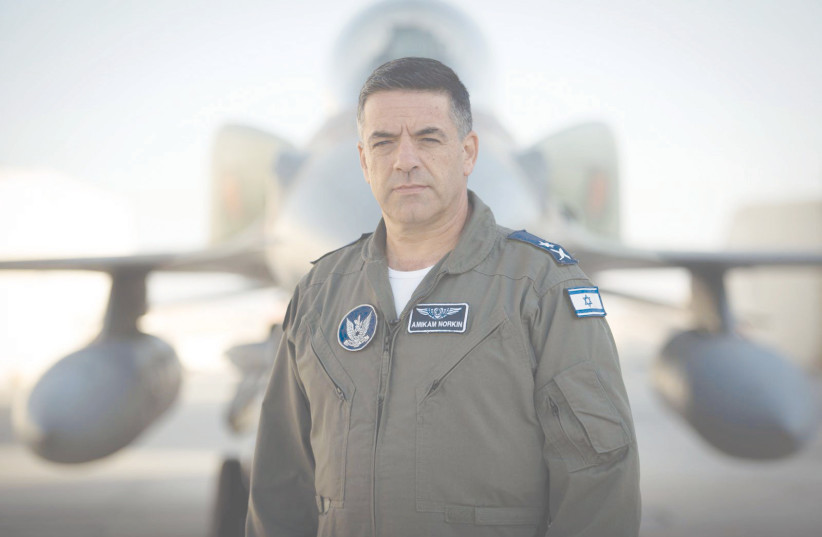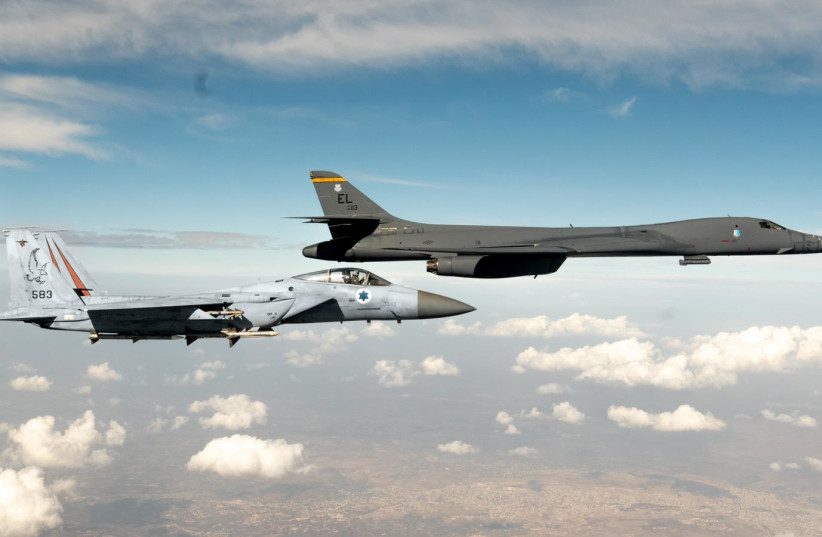by Yaakov Katz
Israeli Air Force chief Amikam Norkin's tenure stands out for the pace and intensity of operations.
 |
IAF COMMANDER Maj.-Gen. Amikam Norkin.
(photo credit: IDF SPOKESPERSON'S UNIT)
|
On Sunday night, an explosion rocked the outskirts of Damascus. Two Iranian military officers were said to have been killed, and pictures from the scene showed a building turned into rubble and a burnt-out pickup truck. What the target was, no one revealed. Who was behind it, no one said either.
The most likely suspect was Israel, which has carried out hundreds of attacks against Iranian targets in Syria in the last few years. Israel, of course, did not confirm its involvement, but there is one thing for certain: if it was Israel, Maj.-Gen. Amikam Norkin, commander of the Israeli Air Force, would have been in his command post that night watching as another successful mission was carried out by his pilots.
Norkin, 55, will retire in a few weeks, ending a nearly five-year term as commander of Israel’s vaunted Air Force, often referred to as the Jewish state’s insurance policy. He graduated from the IAF’s prestigious pilot’s course in 1985, becoming one of the youngest F-15 pilots in the world, and was one of the first squadron commanders when the F-16i “Sufa” arrived in Israel. Norkin went on to command bases and serve as head of the IAF’s Operations Directorate, overseeing, for example, the bombing of Syria’s nuclear reactor in 2007.
But where Norkin’s career really stands out is in the intensity of that tenure. He is not the first IAF commander to use force and oversee combat operations – there were others before him who commanded wars on multiple fronts – but the intensity of the last five years has been something not seen before in Israel.
Almost every week – sometimes more than once – Israeli pilots are crossing borders and flying throughout the region on intelligence-gathering operations, and, like what might have happened on Sunday near Damascus, bombing missions. This is part of what is referred to as the “War between Wars,” widely known by its Hebrew acronym MABAM.

A US Air Force B-1b heavy bomber was escorted by an IAF F-15 fighter jet above Israeli airspace on October 30, 2021 (credit: IDF SPOKESPERSON'S UNIT)
Here is just one statistic to illustrate the intensity of IAF missions: until 2015, only five surface-to-air missiles were fired at Israeli jets from Syrian territory. Since then, there have been more than 1,200.
The intensity is a mix of almost everything – different Russian systems in use by the Syrian military as well as new Iranian systems deployed there about a year ago, a sure sign of how the challenge is only growing.
Some are small-scale strikes against single targets. Others are bigger, louder and riskier. For each, Norkin is in the underground IAF command center overseeing the operation and ensuring that the pilots return home safely.
Beyond the operations, Norkin has altered the structure of the IAF. The Hatzor Base – once a mix of F-16s and unmanned aerial vehicles – is now solely for UAVs and air defense. The F-16s have moved to a base in the North.
The idea is to concentrate capabilities and improve them, keeping the force more focused on missions to try to make them more effective. Drones will operate from Hatzor as will a new command center for missile defense, a single place that will have eyes on all of Israel’s systems that protect the country from enemy missiles: Iron Dome, David’s Sling and Arrow.
The same has happened with the IAF’s special forces. The three elite commando units that operate under the IAF – the Shaldag unit, the 669 search-and-rescue unit, and a small squad that specializes in assisting Hercules transport aircraft on land in makeshift runways behind enemy lines – were each previously independent. Norkin changed that, consolidating them into a special Air Force wing. The idea was to ensure that all units retain the IAF standard and stay focused on their main mission and goal of ensuring Israeli aerial superiority.
One great example is Shaldag. Teams from the elite commando unit have participated over the years in dozens of operations not connected to the Air Force, including for example some two dozen missions during the Second Lebanon War in 2006. While Norkin does not have a problem outsourcing the units and their capabilities, he does want them more focused.
One place where Norkin has left an indelible mark has been his growing of IAF ties with other air forces across the globe. An example was the recent bi-annual Blue Flag aerial exercise held in Israel in October. More than 1,500 people participated in the drill, which brought to the country jets from India, the United States, Italy, the UK, Greece and France.
It was the first time that a British fighter squadron deployed in Israel since the establishment of the state, as well as the first time that India sent a Mirage fighter squadron to Israel. The highlight was the arrival of UAE Air Force chief Maj.-Gen. Ibrahim Nasser Mohammed al-Alawi to watch the drills. A month later, Norkin flew to Dubai and met with Alawi as well as with a top Jordanian air force commander.
Norkin believes that air superiority is a bridge for regional stability. The first derivative is the joint training done at exercises like Blue Flag, which was in such high demand that the IAF had to reluctantly turn away some countries, as Israel’s narrow skies just could not accommodate so many airplanes.
The second derivative is that these opportunities foster intimacy between air forces, which helps Israel cultivate legitimacy for its operations. When these commanders visit and train alongside the IAF, they gain an appreciation for how the IAF operates. That alone helps create a better level of understanding the next time Israel launches an operation against Hamas in Gaza, or strikes at a mysterious Iranian target in Syria.
An example of this was felt in November 2019, when the Air Force targeted a top Islamic Jihad commander in Gaza in a surprise strike that set off a few days of fighting. Some foreign air force commanders happened to be in Israel for a drill they had come to observe, so when they left their hotel in Tel Aviv and saw Iron Dome interceptors flying through the sky they thought it was part of the drill. And no one left the country despite the ongoing clashes.
Within the region, the opportunities remain to be tested. While Israel is still far from the day when its pilots will launch joint operations with Emirati or Bahraini pilots, the alliance between the countries creates greater maneuverability and flexibility for Israel as it faces greater threats to its aerial freedom of operations.
And the threats are growing. Air defense systems are proliferating throughout the region, with constant attempts being made to down IAF jets. UAVs are flown across the border into Israel from Syria, Gaza and beyond. This demands that the IAF constantly adapt and refine its tactics and technology, which it did by initiating, for example, the development of radar systems that can pick up the signature of even small drones.
The situation in Syria is delicate and has Norkin and his pilots worried. If Israel loses the ability to coordinate operations with Syria – through what the IAF calls a “safety mechanism” – then it would face a challenge of strategic proportions. Iran will be able to take advantage of the suspension in Israeli action to move more weapons into Syria and Lebanon, and the IAF will have its hands tied.
Ultimately, the decision of how to proceed is up to the political echelon, but Norkin has made his and his pilots position clear to those who need to know: Israel must retain the ability to operate in Syria.
Over the last few weeks, Norkin has crisscrossed the country, bidding farewell to the bases that made up the milestones of his long flight career. It has been a hectic five years for Norkin, and he has earned a break.
Looking at the different moments that made up his tenure, one stands out: the time he flew a Baz-model F-15 over the Knesset alongside a Eurofighter painted with the flags of Israel and Germany and piloted by the commander of the Luftwaffe, Lt.-Gen. Ingo Gerhartz. It was an emotional moment and illustrated how even among the daily battles, history cannot be forgotten.
“The sounds of our wings of history are heard throughout the skies of Israel’s capital,” Norkin said over the air force’s internal communications system, as he and Gerhartz flew in formation over the Knesset. “With the memory of a dark past, we look toward a hopeful future while retaining a deep commitment to Israel’s freedom.”
Yaakov Katz
Source: https://www.jpost.com/opinion/article-700975
No comments:
Post a Comment